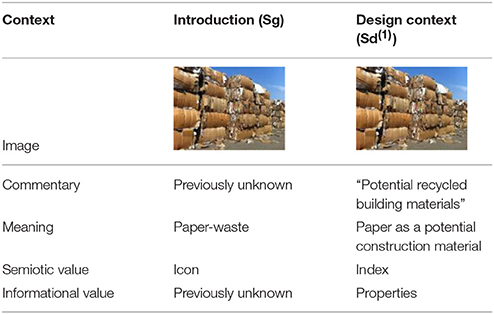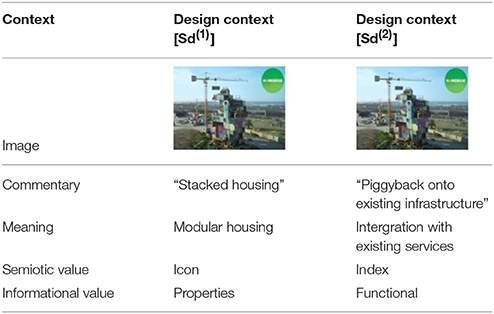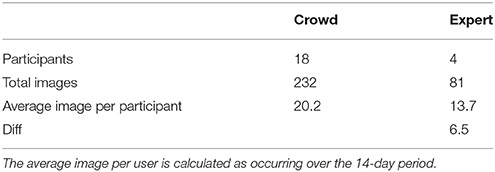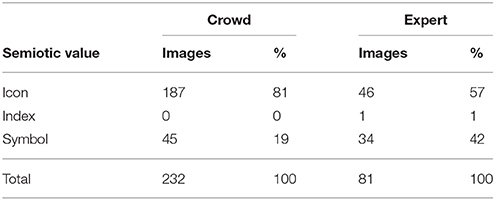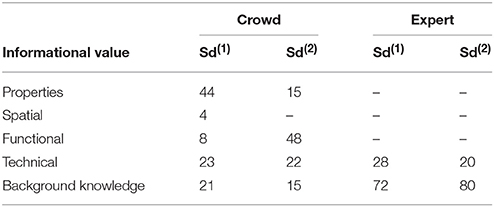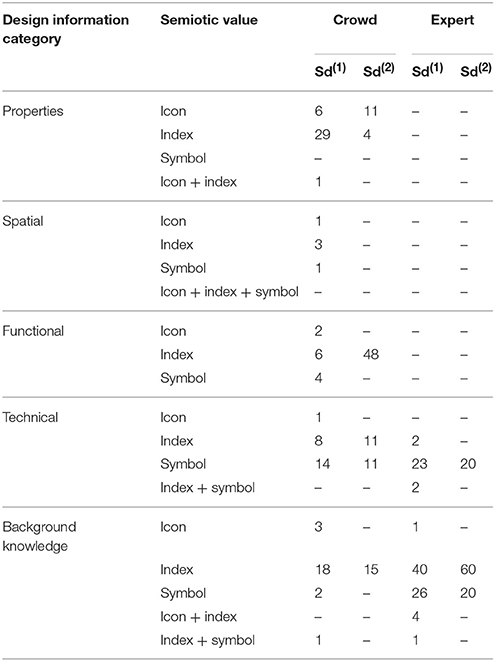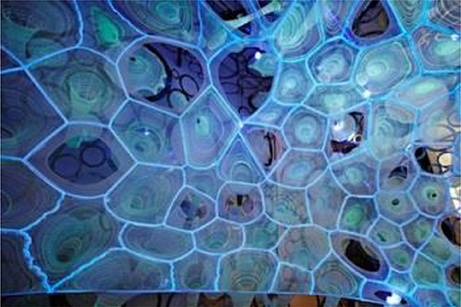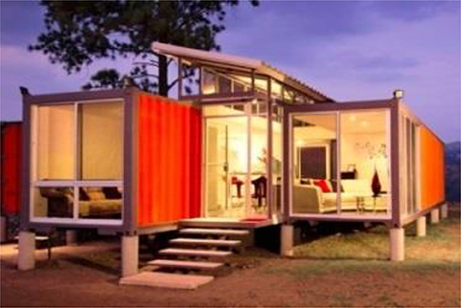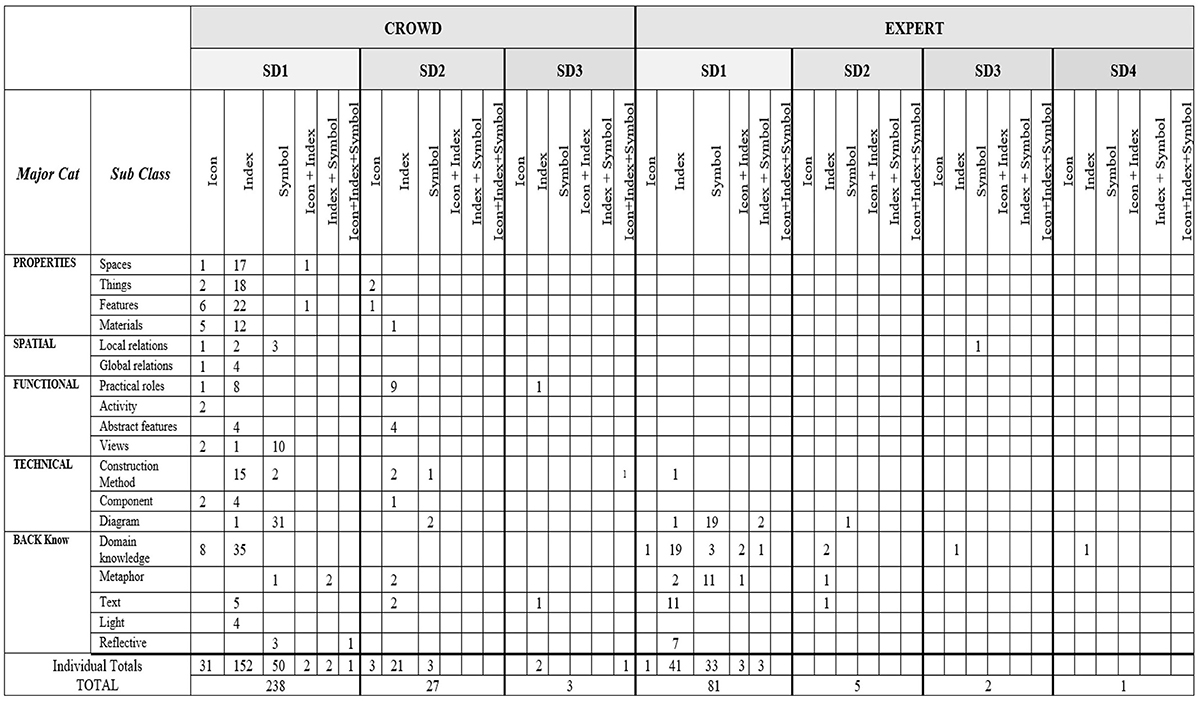- 1School of Architecture and Built Environment, University of Newcastle, Callaghan, NSW, Australia
- 2School of Art, Architecture and Design, University of South Australia, Adelaide, SA, Australia
Drawing on the theory of semiotics, this research measures the differences between a non-expert web crowd and an expert design group, when communicating using varying forms of digital representation in a web-based environment. Using an online tool to capture the interactions in each group, the paper analyses how they independently engage in a design task. In lieu of the crowd's varying levels of design and disciplinary expertise, semiotics is employed to describe and compare how representation is used to conceptualize and express design meaning in both groups. Through this research the paper illustrates that representation is a universally understood object of meaning-making and it demonstrates the capture of design intelligence from the web crowd in terms of its ability to generate design meaning in a collectively shared online space.
Introduction
With the explosion of web-based communication technologies and shared economy it is now possible to realize and support mass participation in design. Web-based technologies are increasingly using rich media content to allow large groups or crowds of motivated online individuals to contribute toward solving complex problems (Lévy, 1997; Yu and Nickerson, 2011). A notable example of the crowd's potential for problem solving is Khatib and DiMaio's “Foldit” (Khatib and DiMaio, 2011). Foldit provides an interactive 3D protein based puzzle game allowing any individual to contribute – via the successful completion of the puzzle–to a highly complex scientific research problem. The application of collective human intelligence to design is achieved through leveraging web-based outsourcing systems, known as crowdsourcing (Maher et al., 2010; Paulini et al., 2011). The drawback with the typical crowdsourcing model currently applied to design tasks relies on an online “crowd” in which members work in isolation through the agency of a heavily mediated structure, to support the design process (Phare et al., 2016). Such structures require participants to work alone, according to a set of stages that artificially model the design process, and then submit work for assessment or public voting. Simply stated, crowd members who engage in crowdsourced design effectively function independently of one another and without real-time communication. Because of this situation, the online crowdsourcing structure neglects the premise that design is often characterized as much by its collaboratively social activity (Cross and Cross, 1995) as it is by the process of design itself (Ratti and Claudel, 2015). This realization also points to a practical limit of collective intelligence in design within the current crowdsourcing context.
Collective intelligence is recognized as a universally distributed intelligence; constantly enhanced and coordinated in real time, resulting in the effective mobilization of skills (Ratti and Claudel, 2015). Crowdsourcing rarely provides a platform for members to coordinate their activity in real time. Because of this, it denies the crowd the social opportunity to freely express design meaning independently of the mediated context. Thus, the result is more likely that of “collected” intelligence than “collective” intelligence (Maher et al., 2010). Levy (Lévy, 1997) argues that one of the critical criteria for successful collective intelligence is real time coordination. Real time coordination is fundamental for social activity where the freedom to express and communicate enables the distributed intelligence to constantly enhance (Teresa, 2016) itself. These three criteria alone offer striking parallels to the social activity of design (Cross and Cross, 1995). The work of Maher, Paulini and Murty (Maher et al., 2010) even provides a conceptual framework that describes the three criteria for enabling design in this collective context; motivation, communication, and representation. Motivation and communication have been extensively explored in the past (Maher et al., 2000; Paulini et al., 2014), but representation has garnered significantly less attention. Representation is an important vehicle for generating and communicating design meaning (Asimov, 1962; Schön, 1983; Goldschmidt, 1991; Suwa and Tversky, 1997; Goldschmidt and Casakin, 1999; Goldschmidt and Klevitsky, 2004). What is not so well known is how a universally distributed collective intelligence would use the representation to express and design related knowledge under open, real time conditions.
Background
Representation in design often relies on the use of graphic notational objects. By exploiting the informational potential of the representation, the experienced designer can explore an infinite world of ideas and concepts (Ari Akin, 2001). Fluency with representational artifacts enables designers to effectively communicate design at all stages of the process with other design professionals. Such graphic notational objects are generated by using a range of analog media (graphite and ink), digital media (3D CAD modeling) or a combination of both (Arias et al., 1997; Ari Akin, 2001). It is expected that most non-designers will not possess a similar fluency with design notations. However, the ability to exploit the informational potential of various notational signs, including models, maps and pictures, is recognized, designer or not, as a universally human ability. This skill is summarized as the concept of pictorial competence (DeLoache et al., 2003), which is a sign-based ability that allows us to understand the representational content of “pictures, ranging from the straightforward perception and recognition of simple pictures to the most sophisticated understanding of specialized conventions” (DeLoache et al., 2003). With pictorial competency being a sign-based ability, the informational potential of a group of signs can be well accounted for by leveraging semiotic principles. To that end, design and semiotics share several procedures that are directly related to the function of design representation they both rely on descriptively graphic notation systems to provide functional and generative content, often in simultaneous combination (Ashwin, 1984).
Semiotic theory deconstructs signs depending on how they allow for comprehension. In Peircean semiotics the Representamen (the form a sign takes), the Object (the entity to which the Representamen points), and the Interpretant (the qualities expressed by the Representamen) (Nadin, 1990; Chandler, 2002; Chapman et al., 2004; DeGrassi et al., 2008; Everaert - Desmedt, 2011) collectively make up the triadic framework under which signs, or signifiers, are organized. Peirce (CP 1.369) categorized such signs as an Icon, Index, or Symbol, each of which point to the leading quality and characteristic of the sign itself. A signifier as an Icon possesses a physical similarity to the signified, the object or person being represented. A good example is a photograph or a portrait (Nadin, 1990; Rogers, 2008). A signifier as an Index provides evidence of what is being “signified” (Rogers, 2008). A good example is an image of a footprint to indicate the presence of a human. A signifier as a Symbol does possess any logical relationship to the signified (Rogers, 2008). Any connection to what is being represented is purely conventional (Nadin, 1990; Rogers, 2008). Symbols operate not by using visual or conceptual connections to the signified, but through a socially established convention (i.e. something that must be learned before the meaning of the symbol can be understood) [CP 1.369, Maher et al., 2000; Neuman, 2015]. Good examples are flags. In relation to design Peirce (CP 5.171) referred to the borrowing of existing iconic, indexical and symbolic characteristics, to describe intangible concepts such as ideas, as “abduction.” Abduction is an approach to reasoning whereby existing visual components are used to describe something that does not yet exist. It is crucial for the creative process because it enables the individual to reflect upon elements embedded within existing iconic imagery to communicate new concepts. The interdisciplinary strength of semiotics derives from its ability to allow researchers to conceptualize meaning and value (Neuman, 2015) in anything that can be interpreted as a sign. In a design context, the Icon, Index, and Symbol of Peirce's semiotic theory and the medium of the representation provides an opportunity to consider the visual communication of design meaning.
Methods and Research Design
There are no universally agreed statistics that provide a numerical definition of a “crowd.” However, in direct relation to collective and crowd intelligence Surowiecki (Surowiecki, 2004) articulates that a crowd is not characterized in numbers, instead it is better represented through the diversity of its constituent members. Therefore, we recognize defining what a “crowd” is or its diversity in terms of numbers and behavior (Adeyemi et al., 2016) is both top-down and problematic. The careful selection of crowd participants, combined with laboratory conditions, would produce a contradictory and less than faithful facsimile of naturally diverse decentralized crowd intelligence. To avoid the intentional selection of crowd participants we chose a bottom-up approach in which the crowd could define itself. To stimulate the self-generation of the crowd our recruitment phase concentrated on raising awareness of the study via social media advertising. Agreeing to participate in the study voluntarily the responding participants ultimately defined the final number at 18 and each member of our small crowd was highly active during the design session which remained accessible for 14 days for each group. The range of personalities, gender (62% male) and diverse range of occupations (factory, warehouse and retail worker alongside a web designer, a student, a psychologist, and tow real estate retirees) was sufficient to simulate a small crowd in a laboratory environment. In contrast, the expert benchmarking group consisted of four practicing architects each with over five years of design and teaching experience. Drawing on the experiential differences between the expert and crowd groups, the results of four expert participants' design activity within Prezi could provide a baseline data set sufficient for comparative purposes with the crowd group. The online environment adopted for this study was a shared presentation tool called Prezi, which was selected based on its capacity to provide participants with an openly-shared online space. The design brief was framed around the conceptual development of an environmentally friendly and affordable modular housing scheme. Through using this conceptual approach, we aimed to maximize the amount of representational activity that could be captured and analyzed. At the conclusion, the images and interactions captured in the collective environments were compared, such that the differences between the expert and crowd groups could be determined. The results of the expert group would provide a baseline dataset sufficient for comparative purposes with the ones of the crowd group. For insight into how the crowd might use the representation to express design meaning the data collected from the experiment was coded using semiotic theory in conjunction with Suwa and Tvresky's (Suwa and Tversky, 1997) design information categories. The result is a coding method specifically developed for understanding meaning generation in a collective design context.
Coding Semiotic Values
To review the role of representation in this experiment, it was necessary to code the activity involving the representation from the moment external imagery was introduced into the online design environment. By employing Peirce's theory of signs (CP 1.369) it was possible to catalog the pre-design semiotic state through the dominant semiotic characteristic of the image. The design related semiotic value of each image was cataloged with the aid of the accompanying commentary provided alongside the image.
To obtain a general and non-design related semiotic baseline each image was initially categorized according to one of Pierces three semiotic types (coded as: Sg = Icon, Index or Symbol in a general semiotic context). The subsequent binding of any selected representation to a design narrative produces a fresh context and semiotic value in that representation. Movement from a non-design semiotic context (Sg) to (and thereafter within) a design context (Sd) was considered a transitional movement. In this article the design related semiotic value of the image is considered as Semiotic(s) in the design context [Sd(n)]. The semiotic movement from a general context to a design context is captured as:
When the image is reused or interacted with by other participants its semiotic value is modified to express new design related meaning. In doing so a shift occurs away from what the Icon, Index or Symbol was originally intended to signify, to a new or additional signified meaning shared within the crowd. Subsequent transitions within the design context are coded as:
Coding Informational Values
To identify the informational content, we adopt Suwa and Tversky's (Suwa and Tversky, 1997) suggestion that pictorial devices can be used for expressing meanings and concepts in design. These meanings and concepts fall across four major domains of design information. The domains (with related subclasses) are: (i) depicted elements, (ii) spatial relations, (iii) abstract relations, and (iv) background knowledge. Although the major categories were developed primarily in relation to the study of sketching in design, their ability to provide a representational cataloging method is equally relevant to this context. Suwa and Tversky's (Suwa and Tversky, 1997) domains are adopted, simplified and extended with the addition of an extra domain of design information categorized as a technical domain. The purpose of the extra domain is to consider any technical information offered by the crowd. The resulting five major categories are: Properties, Spatial, Functional, Technical, and Background Knowledge. To simplify the categorisation of the imagery in this article of Suwa and Tversky's (Suwa and Tversky, 1997) Sub classes are not included and only the major category is used. The combined semiotic values and informational categories are written as:
Example of an Sg to Sd(1) transition [Sg → Sd(1)] is illustrated below and in Table 1:
Subsequent transitional movements between design meanings can be coded indefinitely as additional Semiotics in the design context [Sd(2), Sd(3), Sd(4)]. The accompanying text based commentary (provided by the participants) enabled each semiotic value to be cataloged against one of the five major categories of design information. Whilst accompanying commentary was used to provide context for the semiotic and informational cataloging, a full standalone textual analysis was omitted on the basis that an independent semiotic apparatus would be required and is beyond the representational focus of this article.
Example of an Sd(1) to Sd(2) transition [Sd(1) → Sd(2)] is illustrated above and in Table 2:
By combining the semiotic values alongside design information categories, it is now possible to determine methodically what the intended meaning is and how it evolves and is constructed over time. The result of coding the qualitative representational data this way produces the quantitative data necessary for an analysis (see Appendix for a table showing a full data set).
Results
To make the comparison between expert and crowd groups effective, it was determined that only the first three transitions presented enough data [Sg → Sd(1) → Sd(2)] to be accounted for. To exclude data that may yield unreliable results a threshold was imposed. Any activity involving less than 5% of the initial net value of 232 images was considered unusable. Therefore the remaining data considered viable for a comparative analysis was reduced from the five transitions that did occur to three transitions [Sg → Sd(1) → Sd(2)] with the data for transitions Sd(3) through to Sd(4) omitted.
Representational Distribution
The following analysis is achieved using statistical and cumulative information drawn from the coded activity of both groups. To cumulatively describe the generation and change in design meaning we undertake a combined quantitative comparative analysis. The quantification of design meaning is achieved through coding the semiotic value of each representation. By coding the lifecycle value of the individual image (from introduction to subsequent design related use) we could capture the informational changes in design meaning as they occur over time. The results are as follows.
The crowd group uploaded 238 general images from external sources and the expert group uploaded 81 images. In the crowd group, six images of the original 238 images were copied with the accompanying text “I like these”; not accounting for approval as standalone design information the total final image count was 232 images (238 with six non-included duplicates). The expert group did not reuse any images and so their total contribution remained at 81 (Table 3). The experts used an average of 6.5 more images per participant than the average crowd member at 13.7 images per participant (Table 3).
Of the 232 images initially introduced by the crowd, 188 were coded as icons and 44 as symbols. No indexical images were provided. Of the 81 images introduced by the expert group, 46 were iconic, one was indexical and 34 were symbolic (Table 4). The initial use of imagery in the expert group was heavily based on importing the icons, or symbols. In total the expert group introduced 57% icons and 42% symbols with 1% indexes over 14 days. Of these, five were initially interacted with, followed by another two interactions, with one final interaction based on the same imagery. The initial use of imagery in the crowd group was also heavily based on importing the icons, or symbols, but the percentage of the icons was significantly higher than in the expert group (81 vs. 57%) while the percentage of the symbols was significantly lower (19 vs. 42%).
Representational Distribution
Table 5 shows the proportional distribution of the representations' informational values within the major categories of design information of both expert and crowd groups. A chi-square test showed that the proportion of images assigned to the five categories (Properties, Spatial, Functional, Technical, and Background Knowledge) differed significantly between the expert group and the crowd group, χ2(4) = 90.3, p < 0.001. Table 5 shows that most of the expert group's images are in the Background Knowledge category (72.2%) and the Technical category (26.7%), whereas the crowd images are more widely spread across the Properties category (33.6%), the Background Knowledge category (23.9%), and the Technical category (22.8%).
Table 6 shows combined proportional distributions of semiotic values within the major categories in both groups.
Discussion
From the experiment, it was observed that both groups imported iconic and symbolic imagery. This was either scanned (such as book pages) or directly sourced from the web. The symbolic drawings where either imported existing drawings or personally created such as hand sketches and Adobe Illustrator drawings. Both groups used common formats such as Graphics Interchange Format (*.gif) or Joint Photographic Experts Group (*.jpeg) images. Both groups displayed a pictorial competence in using the existing features in iconic imagery to indexically communicate abductive meaning, such as ideas and concepts.
The participants in both groups engendered design meaning into imagery by freely employing various characteristics borrowed from the embedded qualities of existing icons. Mapping both groups to determine how they used the icon abductively to generate analogies indexically showed that despite the presence of abductive reasoning in the ODE, the content of the abductive reasoning was unique to both groups. Since the abductive process is difficult to measure at best, this discussion focuses on the outcomes of the differences in reasoning processes exhibited through representational use in the expert and crowd group. The types of reasoning exhibited are described according to the two characteristic aspects: expert top-down and novice bottom-up.
In the expert group, the design information was far more abstract in that the images were often used to convey meaning that was visibly very far from the content of the image. For the experts, the information was of a much higher level of abstraction. Often the image in an expert's circle would be a pattern, a sketch or an image of a material with references to building skins. Figure 1 is an example of an image used by an expert. It is a novel material (unknown) exhibiting exposed membrane. The purpose of this image was to expresses a range of abstract considerations (1) the material as construction methods, (2) the interconnected modular component supported by the membrane, and (3) the exploration of new approaches to modularity through membrane structure.
As such, the level of information generated by the experts was of a much more analytical nature. For the experts, the autonomous exploration of the issues on a much wider conceptual and analytical scope was a defining characteristic of the how they used the representation to generate meaning throughout the entire experiment. In contrast to using imagery to generate informational schemas and explore subproblems (as observed in the crowd), the experts used imagery to complement a deeper, more explicit problem-decomposing strategy (Cross, 1999). In the ODE the experts engaged with the design task by using a mixture of qualities found in general iconic and symbolic representations to abstractly reflect components considered key to the design task. By extracting various qualities of imagery in seemingly vague and abstract ways, a deeper, more explicit problem-decomposing strategy became evident. This approach was less concerned with a final solution; instead the imagery was used to define the parameters of the problem (Cross, 1999). A much higher level of abstract indexical meaning was engendered in the imagery by decomposing the design problem and using iconic representations to infer analytical components. In design literature, this is regarded as being a predominantly top-down and breadth-first approach (Cross, 1999).
For the crowd, the images selected appeared to reflect not only their perception of the design task, but their considerations of a subproblem. This characterized the crowd's involvement with the design task for the duration of the experiment and produced a wealth of information but no design decisions were made. This perceived visualization was informal and in the ODE the contributions initially appeared arbitrary, random and unordered. This in part can be explained in the sense that it was “ordinary,” “familiar” or “constructed” in the absence of any formal code or set of design related rules (Bonollo and Montana-Hoyos, 2011). Importantly for the crowd, the combination of the icon and the ODE presented the opportunity to communicate very easily discernible information by analogously using immediately recognizable qualities of images. One crowd member introduced an image of a refurbished shipping container (Figure 2). The intention was to indexically express a component suitable for modularity; furthermore, the image contained indexical information regarding a potential furnishing.
It emerged that each participant performed similarly in that design meaning was isolated to their scope of design knowledge, understanding or insight into certain individual elements of the task. In this respect, in the crowd group, the representational use was governed by predominantly literal design meaning—literal because the images were often used to convey meaning near to the content of the image (Bonollo and Montana-Hoyos, 2011). For example, the crowd participants inserted a collection of images that would cumulatively generalize certain categories of information such as environmental factors, technical considerations or schematic constructs (such as drawings, plans, and elevations). In the crowd images supporting knowledge that was predominantly concerned with exploring themed sub solutions were common. This type of bottom-up activity within design is often associated with novice activity and defined as the “depth-first” approach when involved in solving design problems (Cross, 1999). For the crowd, the autonomous exploration of the sub elements of the task, rather than the whole task itself, was a defining characteristic of their use of the image throughout the entire experiment. Having generated the information [via the Sg → Sd(1) transition], certain participants began to add new interpretations (at varying levels of abstraction) indexically for the sole purpose of contributing new informational variables to the existing design-related meaning of the image via the Sd(2) → Sd(3) transition.
Limitations
The observation in this study is limited to a number of factors. First, there are no specific online tools designed to handle collective design tasks as outlined in our study, as such we were required to tailor an online presentation tool as our design environment. Secondly this was the first attempt at a collective design task under decentralized collective conditions and the notion of crowd is inherently unpredictable, the final participant number for our crowd was 18. Furthermore, semiotics alone can be heavily influenced by observer dependency. To reduce semiotic coding subjectivity the informational context was obtained from the accompanying text, however with the representation the focus the accompanying text was not specifically analyzed. In order to establish reliability of the coding, two rounds of segmentation and coding were conducted, separated by an interval of 2 weeks. Inter-rater reliability for these two coding rounds was established using the Intraclass Correlation Coefficient (ICC; absolute agreement, two-way mixed, average measures). The range of the ICC was between 0.0 and plus or minus 1.0. Combined, these factors imply that whilst the results obtained do not represent a perfect facsimile of collective conditions, collective design or a perfect interpretation of meaning they do provide a probabilistic evidence for the existence of a collective pictorial competence that can be drawn upon, under the right conditions, for the purpose of collective design tasks. To expand this preliminary investigation, we will concentrate on areas such as dedicated online tools, increased participant numbers, types of interaction as well as providing an expanded method in which textual semiotics are co-analyzed in concert with representational semiotics.
Conclusion
We have examined the role of the representation in a collective context by a method highlighting combined semiotic and informational values. The primary aim was to understand if, or how a crowd member might use the image to generate design meaning. Using an expert group for comparison and through the comparative analysis we observed that whilst both groups similarly relied on the image to communicate design meaning there were observable differences in the relationship between image and the design meaning generated.
In the expert group an emphasis on symbolic information contributed to a generation of high level abductive meaning indicating a complex “breadth-first” approach to the design task. Working autonomously and at an individual level each member of the expert group engaged with the representation and demonstrated identifiable expert characteristics such as complex abstract thinking and top-down problem-decomposing. The outcome was the generation of high level abstract design meaning shared within the global knowledge base. The design meaning generated was also the sum of their individual rather than collaborative contributions. The experts did add meaning to existing imagery supplied by other members, although it was referential and at no stage did the experts add commentary to another expert's image. The “top-down” nature of the experts' decomposition strategy demonstrated that their abductive reasoning generated a fraction of Suwa and Tversky's (Suwa and Tversky, 1997) design-related information in comparison to the crowd.
In contrast the cumulative activity of the crowd was an informational range which covered every category of Suwa and Tversky's (Suwa and Tversky, 1997) design information categories. Working via a “bottom up” approach, the crowd actively used the icon to generate abductive indexical design meaning. By the end of the design session the total sum of the crowd's abductive activity culminated in a knowledge base far greater than the sum of the individuals' contribution(s). This observed activity produced a reciprocally beneficial situation for the crowd in that by increasing the knowledge base; they would in turn gradually increase the indexical semiotic richness of their design information prompting further interaction. Furthermore, as the activity increased we observed the “crowd” members increasingly engaging in self-organization and the self-contextualisation of content. With the self-generation of its own visual stimuli the indexical knowledge base increased, our analysis showed that over time the accumulation of images provided enough of a stimulus to initiate further creative exploration.
In this paper the iconic representation facilitated the generation of indexical and symbolic meaning within each group. In the crowd group, a wide range of low level conceptual indexical design meaning was generated, whereas in the expert group a much narrower range of higher symbolic conceptual thinking was observed. By pointing toward the image and its role in the generation of informational meaning; this paper demonstrates a potential to provide an effective mechanism based on semiotics for identifying and analysing online, crowd based, design behavior. Ultimately the findings developed might assist in building more effective web-based environments and platforms for supporting open, real time design interaction and collaboration.
Ethics Statement
This study was carried out in accordance with the recommendations of Human Research Ethics Committee at the University of Newcastle, Australia with written informed consent from all subjects. All subjects gave written informed consent in accordance with the Declaration of Helsinki. The protocol was approved by the Human Research Ethics Committee at the University of Newcastle, Australia.
Author Contributions
All authors listed have made a substantial, direct and intellectual contribution to the work, and approved it for publication.
Conflict of Interest Statement
The authors declare that the research was conducted in the absence of any commercial or financial relationships that could be construed as a potential conflict of interest.
Acknowledgments
This manuscript is developed based on a significantly expanded version of a previously published conference paper. All appropriate permissions have been obtained from the copyright holders for the use and reproduction of material that first appeared in the refereed paper: Phare, D, Gu, N and Ostwald, M. (2016) Representation in collective design: are there differences between expert designers and the crowd? in Cooperative Design, Visualization, and Engineering Conference: Proceedings of the 13th International conference on Cooperative Design, Visualization and Engineering, ed Y. Luo (Springer International Publishing), 59–68.
References
Adeyemi, R., Shukor, A., and Mazleena, R. S. (2016). Understanding online behavior: exploring the probability of online personality trait using supervised machine-learning approach. Front. ICT 3:8. doi: 10.3389/fict.2016.00008
Arias, E., Eden, H., and Fischer, G. (1997). “Enhancing Communication, Facilitating Shared Understanding, and Creating Better Artefacts by Integrating Physical and Computational Media for Design,” in Proceedings of Designing Interactive Systems: Processes, Practices, Methods, and Techniques. Amsterdam, ACM, 1–12
Ari Akin, Ö. (2001). “Simon Says,” in Design is Representation, (Pittsburgh, PA: Arredamento Mimarlik), 82–85.
Bonollo, E., and Montana-Hoyos, C. (2011). “Drawings and the development of creativity and form language in product design education,” in Proceedings of the Creativity:Brain–Mind–Body ACUADS Conference 2011 (Canberra, ACT).
Chapman, M., Ostwald, M. J., and Tucker, C. (2004). “Semiotics, interpretation and political resistance in architecture, contexts of architecture,” in The 38th lnternational Conference of Architectural Science Association ANZAScA 2004, (Launceston, TAS).
Cross, N. (1999). Expertise in design: an overview. Design Studies 25(5), 427–441. Atman, C.: A comparison of freshman and senior engineering design processes. Design Stud. 20, 131–152.
Cross, N. A. C., and Cross (1995). Observations of teamwork and social processes in design. Design Stud. 16, 143–170.
DeGrassi, M., Giretti, A., and Ansuini, R. (2008). “Models of design activities: towards effective design scaffolding,” in Browsing Architecture-Metadata and Beyond, eds M. Zambelli, A. H. Janowiak, H. Neuckermans (Stuttgart: Fraunhofer IRB Verlag), 50–65.
DeLoache, J. S., Pierroutsakos, S. L., and Uttal, D. H. (2003). The origins of pictorial competence. Curr. Dir. Psychol. Sci. 12,114–118 doi: 10.1111/1467-8721.01244
Everaert - Desmedt, N. (2011). Peirce's Semiotics. Available online at: http://www.signosemio.com/peirce/semiotics.asp
Goldschmidt, G. (1991). The dialectics of sketching. Creat. Res. 2, 123–143 doi: 10.1080/10400419109534381
Goldschmidt, G., and Casakin, H. (1999). Reasoning by visual analogy in design problem-solving: the role of guidance. Environ. Plan. B: Plan. Des. 2000, 105–119.
Goldschmidt, G., and Klevitsky, E. (2004). “Graphic representation as reconstructive memory: Stirling's German museum projects,” in Design Representation, eds G. Goldschmidt and W. L. Porter (Springer-Varlag), 105–126.
Khatib, F., and DiMaio, F. (2011). Crystal structure of a monomeric retroviral protease solved by protein folding game players. Nat. Struct. Mol. Biol. 18, 1175–1177. doi: 10.1038/nsmb.2119
Lévy, P. (1997). Collective Intelligence: Mankind's Emerging World in Cyberspace. Cambridge, MA: Perseus Books.
Maher, M. L., Paulini, M., and Murty, P. (2010). “Scaling up from individual design to collaborative design to collective design,” in Design Computing and Cognition (DCC) 2010, ed J. S. Gero (Stuttgart: Springer), 581–600.
Maher, M. L., Simoff, S., and Gabriel, G. C. (2000). “Participatory design and communication in virtual environments,” in Proceedings. Participatory Conference, eds T. Cherkasky, J. Greenbaum, P. Mambrey, and J. Kabber Pors (New York, NY: PDC2000), 127–134.
Nadin, M. (1990). “Design and semiotics,” in Semiotics in the Individual Sciences, Vol. II, ed W.A. Koch (Bochum: Brockmeyer), 418–436.
Neuman, Y. (2015). “International handbook of semiotics,” in Semiotics as an Interdisciplinary Science, eds P. P. Trifonas (Dordrecht: Springer), 125–134.
Paulini, M., Maher, M. L., and Murty, P. (2011). Understanding collective design communication in open innovation communities. J. CoCreation Des. Arts. 9, 90–112. doi: 10.1080/15710882.2012.716850
Paulini, M., Maher, M. L., and Murty, P. (2014). Motivating participation in online innovation communities. Int. J. Web Based Commun. 10, 94–114. doi: 10.1504/IJWBC.2014.058388
Phare, D., Gu, N., and Ostwald, M. (2016). “Representation in collective design: are there differences between expert designers and the crowd?” in Cooperative Design, Visualization, and Engineering Conference: Refereed Papers from the 13th International Conference on Cooperative Design, Visualization and Engineering, eds L. Yohuia (Sydney, NSW).
Rogers, Y. (2008). ”Icon design for the user interface,” in International Reviews of Ergonomics: 3, ed D. J. Oborne (London: Taylor and Francis), 129–155.
Schön, D. A. (1983). The Reflective Practitioner: How Professionals Think in Action. New York, NY: Perseus Books.
Surowiecki, J. (2004). The Wisdom of Crowds: Why the Many are Smarter Than the few and how Collective Wisdom Shapes Business, Economies, Societies and Nations. New York, NY: Doubleday Anchor.
Suwa, M., and Tversky, B. (1997). What do architects and students perceive in their design sketches? A Protocol Analysis. Des. Stud. 18, 385–403.
Teresa, R. (2016). Challenges in designing smarter mobile user experiences. Front. ICT 3:7. doi: 10.3389/fict.2016.00007
Yu, L., and Nickerson, J. (2011). “Cooks or Cobblers? Crowd creativity through combination,” in Proceedings of the 2011 Annual Conference on Human Factors in Computing Systems (New York, NY), 1393–1402.
Appendix
Keywords: representation, design, crowdsourcing, collective design, semiotics
Citation: Phare DM, Gu N and Ostwald M (2018) Representation in Design Communication: Meaning-Making in a Collective Context. Front. Built Environ. 4:36. doi: 10.3389/fbuil.2018.00036
Received: 10 October 2017; Accepted: 25 June 2018;
Published: 13 July 2018.
Edited by:
Michael Budig, Singapore University of Technology and Design, SingaporeReviewed by:
Christiane M. Herr, Xi'an Jiaotong-Liverpool University, ChinaSandra Manninger, University of Michigan SPAN Architects, United States
Copyright © 2018 Phare, Gu and Ostwald. This is an open-access article distributed under the terms of the Creative Commons Attribution License (CC BY). The use, distribution or reproduction in other forums is permitted, provided the original author(s) and the copyright owner(s) are credited and that the original publication in this journal is cited, in accordance with accepted academic practice. No use, distribution or reproduction is permitted which does not comply with these terms.
*Correspondence: Darin M. Phare, RGFyaW4uUGhhcmVAdW9uLmVkdS5hdQ==
 Darin M. Phare
Darin M. Phare Ning Gu
Ning Gu Michael Ostwald1
Michael Ostwald1